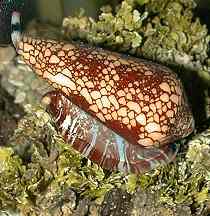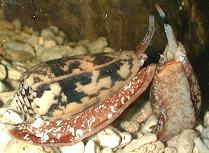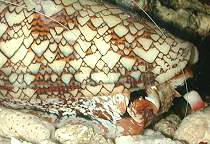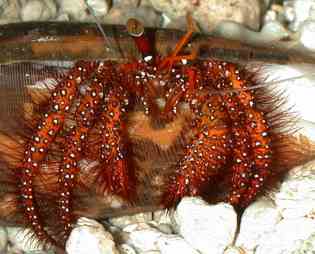April & May, 1999
All photos on the Conewars
article are by Don Barclay.
This article chronicles observations of life in Don Barclay’s aquarium, especially the interaction of different species of cones. It was originally written as a series of e-mails posted to the Conch-L mailing list during April and May of 1999. |
|
|
Meet
“Paul textile”. Paul is on the prowl for his next meal.
Click HERE to learn more about Paul |
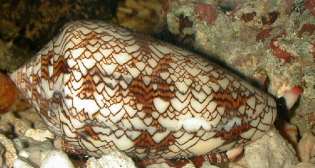 Conus textile "Paul" |
| Cone Wars — Round 1 | ||
|
I
did finally get the aquarium set up, and have been catching fish for
it for the past three days. I went out to catch some cones this afternoon,
and caught most of the ones the ones that I was hunting. I now have one Conus textile, about 80mm ("Art" see #1), one Conus magnificus, 70mm ("Eduardo" see #4), one Conus episcopatus, about 65mm ("Tom" see #2), another episcopatus about 55mm ("Mark" see #3), and a Conus canonicus, 50mm ("Ross" see #5). I still plan to put an omaria (Andy & Gary see #6) or two in the tank, and a couple of bandanus cones. I'll have to make a trip to get a nice sized marmoreus for my experiment: I don't think a 30mm bandanus is a fair fight against a 80mm C. textile. |
||
|
To keep the guys from becoming unnecessarily cannibalistic, I also caught some cowries today, all but one of which is now crawling circles around the tank. I collected one Cypraea talpa, one lynx, four caurica, one erosa, and four arabica, plus a handful of annulus and moneta cowries. I caught a few other cones too (catus, sanguinolentus, capitaneus) but decided not to include them in the equation. |
|
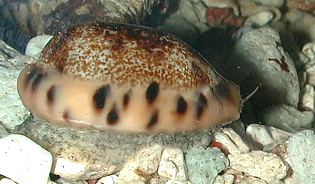 Cypraea caurica |
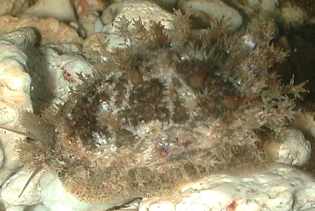 A Cypraea erosa in full evening dress |
|
I didn't even get all the animals in the
aquarium before I saw something I'd never seen before. In my collecting
bottle, my shy magnificus, Eduardo, snaked out
his proboscis and stung one of the Cypraea caurica! And he did
this while he was fully retracted into his shell. He didn't eat the
cowry, as I was in the process of moving them into the aquarium.
I dumped Eduardo's victim into the tank anyway, just to see what would happen. The caurica partially retracted into his shell, but it almost looked like he wouldn't fit. He proceeded to autotomize about the posterior 25% of his foot! I've seen harps do this, as well as several species of nudibranchs, but never cowries. He then remained on the bottom of the tank, motionless, for the next two hours. I went and bought lobsters for dinner, removed the tails, and then fabricated a little scoop to get the dead cowry out of the tank, but… when I went in to remove him, he wasn't where I had left him. In fact, he had crawled to the top of the tank. It wasn't hard to tell which one he was, as only one of the cowries was missing a quarter of his foot. |
|
| Cone Wars — Round 2 |
|
I waited a couple of days to post the initial results of the cone experiment
because I wasn't sure exactly how some of the situations had turned
out, and I'm still not completely certain, but here's how the evening
unfolded:
I dropped all five cones mentioned in the last installment into the aquarium, along with the ten cowries. One of the first things I learned was that fifteen molluscs introduced into a 55-gallon aquarium can produce a lot of slime (or "snail slobber," [sic] as I believe one young lady put it). Within an hour, all the fish were running circles and gasping for air, so I took my skimmer and dipped out all the slime that I could catch, and repeated this exercise several times during the evening. It worked, and eventually the water cleared up, and the slime bubbles stopped covering the surface. It looked like things were shaping up for an absolute cowry slaughter from the very beginning. The cowries immediately hit the aquarium walls and headed for the top, and the big textile cone, Art, was the first to take chase, followed immediately by brothers Tom and Mark Episcopatus. All three headed for different Cypraea caurica (see photo above), and the first to reach one was Tom. It just so happened that this was the caurica that had shed a piece of his foot earlier. His reaction made me realize why cowries aren't extinct. The cowry had crawled right to the water line, and positioned himself parallel to the water's surface, with about a third of the shell above the water line. As Tom climbed up on the cowry, looking for an appropriate spot to harpoon his dinner, the cowry withdrew most of his foot into the shell, clinging to the glass only with the part of his foot that was above the water. Tom spent several minutes trying to figure out where he should sting the cowry, and then... crawled away!
Art Textile had been climbing toward a cowry not far from the one Tom went after, but as he approached his prey, I suppose Tom's cowry either looked or smelled better. About the time Tom decided the situation was hopeless, Art thought he would give it a try, but the results were the same. He didn't seem to find a place to harpoon the guy either, so he turned his attention to a big fat Cypraea arabica a few inches away. The arabica he was about to be eaten, the arabica released himself from the glass. Both he and Art tumbled to the bottom, breaking their union. While Art seemed a bit disoriented, the arabica crawled over to the glass, and climbed straight back to his perch at the top of the aquarium. Mark Episcopatus was also on the prowl at this time, and I got a bit more education by watching what he did. The third Cypraea caurica was easing along near the water line when Mark approached him from behind. Just as Mark touched him with his siphon, the caurica seemed to realize he was in danger, and sped away from the cone! From watching these cones and cowries interact, it appears that all of the cowry species in my tank are capable of moving about five times as fast as any of the cones, at least moving horizontally on a vertical pane of glass.
Mark turned around and headed back toward brother Tom, and as they met, they seemed to tip their hats to each other, and continued on their way. They were certainly not in a cannibalistic mood with all the cowries crawling around, which was just as I suspected.
I had initially refrained from naming any of the cowries, as I feared they wouldn't survive long enough to justify naming them, but more to come, including the exploits of my Cypraea lynx, "Helmut." |
| Cone Wars — Round 3 | ||
|
When we left off, the cones in my aquarium were not having the greatest success catching their dinner, even though the cowries were swarming all around. The big Conus textile, Art, had already taken one fall from the top of the aquarium, but it wouldn't be his last. Shortly after the two Episcopatus brothers, Tom and Mark, passed each other near the surface of the aquarium, uneventfully, the first of the real cone interactions took place. Art had climbed slowly back to the top of the tank, and was easing toward one of the Cypraea caurica on the left, when he encountered Mark face to face. The two cones sniffed each other, and then seemed to get tangled up a bit, each one apparently trying to climb over the other. In what appeared to be no more than a "get out of my face" gesture, Art zapped poor Mark! Once again, both cones tumbled to the bottom, but only Art crawled away Marcus Episcopatus lay on his side, with his foot only extended a couple of millimeters outside the aperture of his shell. He never moved the rest of the night, other than his siphon, which he could still extend and retract. The fish in the aquarium were beginning to show some interest in the disabled fellow, so I interfered and rotated his shell so that the aperture was down, affording him a bit more protection. Two days later, Mark was still in the same position. Meanwhile, the Cypraea lynx (now named "Helmut") had made about five circuits of the aquarium, crawled over every rock and log, across the top of the aquarium (which is a couple inches out of the water), and investigated every nook and cranny. His next action surprised me once again. After the encounter with Mark, Art had climbed back to the top of the aquarium, and had his sights set on a lonely Cypraea caurica. Helmut
climbed to the top of the aquarium, made a 90-degree turn, and bore
down on Art nose to nose. Instead of going around the Conus textile
or retreating from him, Helmut climbed directly over his foot and siphon
and onto his dorsum, and stopped, as if he had reached his destination.
Within a few seconds, Helmut's weight caused Art to lose his grip, and
for the third time (for Art) they tumbled to the bottom of the aquarium.
Helmut immediately hit the wall of the aquarium and headed back to the
top, but Art had evidently had enough, and remained on the floor of
the aquarium. He crawled over to the Cypraea erosa, who was
half tucked under a rock, and remained there watching him for the rest
of the evening. Helmut wasn't finished. Apparently enjoying the ride from Art, he headed straight up the wall for Tom, the remaining healthy Conus episcopatus. Tom was slowly crawling toward a stationary Cypraea caurica at the water line when Helmut overtook him from behind. Helmut climbed up on Tom's dorsum, this time from the spire, and once again stopped in the middle of the cone's back. The results were the same as with Art, and within a few seconds Helmut had pulled Tom off the wall, both plunging to the bottom of the tank. By now I was wondering whether this was some instinct that Helmut was exhibiting, a new trick he had just learned, or purely coincidence... Tom had had enough excitement for the night after the ride with Helmut, and decided to go to bed hungry. He righted himself, then stood up very tall, with more of his body exposed than I've ever seen before. He lowered his head and began to bury himself in the gravel. His shape lent itself well to this endeavor, and only his spire was visible within one or two minutes. With Tom now buried, Art on a stakeout, and Mark paralyzed, I turned out the main aquarium light and the living room lamp, and got ready to go to bed. I could still see what was going on from the light in the kitchen, and within a few seconds Eduardo, the Conus magnificus, and Ross, the Conus canonicus came to life. Heck, I'd killed most of the night watching the first act of the drama. I figured I might as well stay up and watch the second act.
|
||
|
“Art”
harpoons a Nassarius horridus
|
||
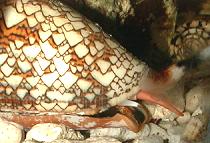 After giving up on the Cypraea lynx, Art Textile settles for a Nassarius horridus (in the lower right corner of the photo). Note the cloud of venom in the water. |
|
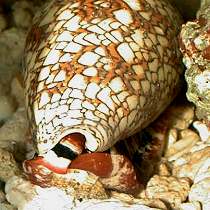 Art finishing off the Nassarius horridus |
| Cone Wars — Round 4 | |
|
With all the lights out except for the light in the kitchen, Mark ailing, Tom buried, and Art licking his chops over an expected erosa dinner, Ross Canonicus and Eduardo Magnificus suddenly showed signs of life. My experience with Conus magnificus in a collecting bag has always shown them to be rather shy, and Conus canonicus is usually not much more active. Eduardo would change my opinion over the next few days, however. After
several motionless hours, Ross decided to explore his
new surroundings a bit. He slowly climbed the wall of the aquarium,
and cautiously approached the line of cowries near the water's surface.
He stopped just short of the first Cypraea caurica,
and extended his siphon to within a few millimeters of the cowry, but
never made any attempt to harpoon it. After a few minutes, he moved
around the unconcerned caurica and headed for the next cowry
in the line. This time he appeared to make a half-hearted attempt at
catching the caurica, but the cowry wasn't nearly as disturbed
by his presence as it had been by Art's approach. It slowly moved away,
and the Conus canonicus didn't follow. Ross simply meandered
around the walls of the tank, and eventually crawled back down and staked
his claim on one of the corners at the bottom of the aquarium. Eduardo hit the glass like he was hungry, and actually out-climbed all of the other cones in the tank. He didn't move nearly as fast as the cowries, but he was quite a bit faster than Art, maybe simply because he wasn't tentative, or maybe all the cowry activity had excited him. In any case, he went straight to the top of the aquarium and rushed up to one of the big Cypraea arabica, which simply ignored him. Eduardo only paused for a moment, evidently discounting his chances, and then moved on over to the next cowry, which was the little fellow with three quarters of a foot that he had harpooned earlier in the day. Eduardo gave this one a closer inspection, but the caurica's trick that had worked on Art and Tom appeared likely to be successful yet again. He was still parallel to the water line, with most of his foot out of the water and the lower side of his shell against the glass. Eduardo was considering what his plan of action was going to be, when around the corner came Helmut. Now, Helmut, the Cypraea lynx, had already pulled both Art and Tom off the glass this night by climbing up on each one's dorsum and allowing his weight to break the cone's hold on the aquarium wall. Would he do the same thing to Eduardo? Amazingly enough, yes. Helmut approached Eduardo from the side, and Eduardo saw him coming. He turned slightly toward Helmut, but the cowry never hesitated. Straight over Eduardo's foot, crumpling his siphon, onto his back... then he just stopped. Eduardo seemed to try to turn or tilt his shell away from Helmut's weight, but in a matter of a few seconds, both were headed for the gravel. Once on the bottom, Helmut quickly crawled over to the glass and resumed making his rounds, and Eduardo wasn't far behind. Eduardo seemed to have the best memory of all the cones (or else he just holds a grudge), as he devoted the next few days to ONLY chasing Helmut, completely ignoring the other cowries. The bane of all the molluscs' existence in my tank has been one blue-and-yellow, inch-long, aggressive little damsel fish. The first thing he discovered about all the cones in the aquarium is that they have little red bites of food attached to these tubes that protrude from the front of the shell, and he felt obliged to try to remove it from every cone in the tank! (All of these cones are related, and each one has a banded siphon, red at the tip, with a white ring behind the red, and a black ring behind the white one.) It almost made me wish one of them had been a Conus geographus. After Eduardo's tumble, the fish harassed him for half an hour, alternating between him and his cousins. Then, for good measure, he zipped up to Helmut, and bit his left eyestalk off! |
|
|
I seem to recall a story of someone keeping a Cypraea testudinaria that regenerated an apparently-functional eyestalk in his tank (Scott Johnson in Kwajalein?), so maybe I'll see if a Cypraea lynx can do the same, assuming he survives. I was beginning to believe that Helmut was going to be at some disadvantage against Eduardo with only one eye – when I noticed that Eduardo's right eye was missing! I determined to remove the mean little fish the next day, but he has completely ignored the molluscs since that night, so I decided to let him stay. |
|
|
By now I was fairly confident that nobody was going to become dinner this night, so I decided it was time to go to bed. As it turned out, I was mostly correct. The next morning, I went to the aquarium and counted cowries to see how everyone had fared overnight. I saw Helmut down in a corner behind some grass, and there were the Cypraea arabica huddled at the top of the aquarium. The juvenile C. talpa had tucked himself into some branch coral, and the erosa was near the spot I had left him. The caurica were spread all over the aquarium, and I counted them: one, two, three, four, five... wait a minute, one, two, three, four, five... Yep, my aquarium had generated one additional Cypraea caurica overnight. I had only brought home four, so I can only guess that there was one in the clump of grass that I had brought in for the fish to graze on!
Mark was still where he had been the night before, and Tom was still mostly buried. Ross remained in the back corner of the tank, and Art and Eduardo had both gone underground. |
|
| Cone Wars — Round 5 | |
|
Everyone
seemed to have survived the night, even if Mark Episcopatus
hadn't moved. I could still see his siphon, and it even retracted a
little occasionally, so I took that as an encouraging sign. As I looked
more closely at the Cypraea erosa that Art had staked out the
night before, I couldn't see any mantle exposed, so I decided to remove
him from the tank and give him a physical. As I suspected, only an
empty cowry shell remained. Looks like Art had his erosa
dinner after all! Everything
remained calm in the aquarium the rest of the day. The cowries stayed
parked in the same spots, with the arabica at the top of the
tank, Helmut Lynx in the corner behind a clump of grass, and the others
scattered around at random. As the evening wore on, I closed the window
blinds and turned out the aquarium lamp, and waited to see if the action
would pick up. It did. |
|
|
One
of Helmut’s brothers,
a Cypraea lynx, narrowly escapes Art Textile |
|
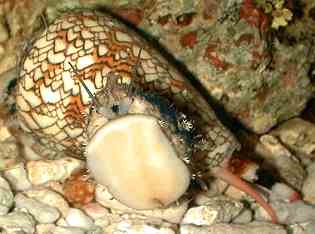 |
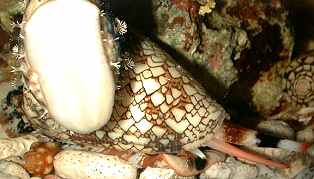 |
|
This is a new counter system set up by Globel on December 01, 2002 |



